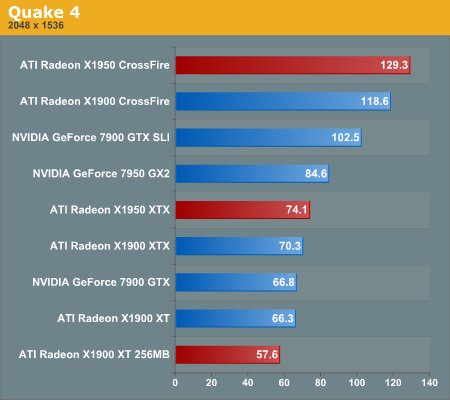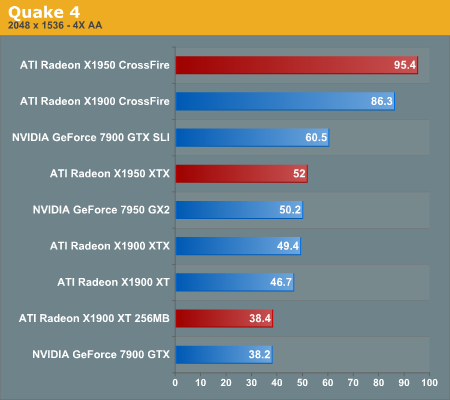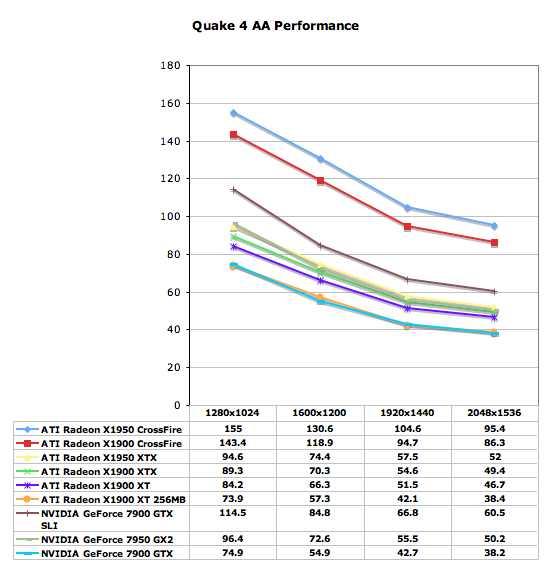ATI's New High End and Mid Range: Radeon X1950 XTX & X1900 XT 256MB
by Derek Wilson on August 23, 2006 9:52 AM EST- Posted in
- GPUs
Quake 4 Performance
There has always been a lot of debate in the community surrounding pure timedemo benchmarking. We have opted to stick with the timedemo test rather than the nettimedemo option for benchmarking Quake 4. To be clear, this means our test results focus mostly on the capability of each graphics card to render frames generated by Quake 4. The frame rates we see here don't directly translate into what one would experience during game play.
Additionally, Quake 4 limits frame rate to 60 fps during gameplay whether or not VSync is enabled. Performance characteristics of a timedemo do not reflect actual gameplay. So why do we do them? Because the questions we are trying to answer have only to do with the graphics subsystem. We want to know what graphics card is better at rendering Quake 4 frames. Any graphics card that does better at rendering Quake 4 frames will play Quake 4 better than other slower cards. While that doesn't mean the end user will see higher performance in the game, it does mean that the potential for seeing more performance is there, for instance if the user upgrades a CPU before the next graphics card upgrade.
Timedemos do walk a fine line between synthetic benchmarks and real world benchmarks. While we tend to favor real world data here at AnandTech, this type of benchmark is very capable of using a real world data set to test the maximum capabilities of the graphics cards under its particular work load without bottlenecking at other points in the system. To be sure, even timedemos can see memory and CPU bottlenecks, as data must be transfered to the graphics card some how. But this impact is much lower than the impact of running AI, physics, script management, I/O, and other game code at the same time.
What this means to the end user is that in-game performance will almost always be lower than timedemo performance. It also means that graphics cards that do slightly better than other graphics cards will not always show a tangible performance increase on an end user's system. As long as we keep these things in mind, we can make informed conclusions based on the data we collect.
Our benchmark consists of the first few minutes of the first level. This includes both inside and outdoor sections, with the initial few fire fights. We test the game with Ultra Quality settings, and we enable all the advanced graphics options except for VSync and antialiasing. Anisotropic filtering is manually set to 8x. Id does a pretty good job of keeping framerate very consistent; in-game framerates of 25 are acceptable. While we don't have the ability to make a direct mapping to what that means in the timedemo test, our experience indicates that a timedemo fps of about 35 translates into an enjoyable experience on our system. This will certainly vary on other systems, so take it with a grain of salt. But the important thing to remember is that this is more of a test of relative performance of graphics cards when it comes to rendering Quake 4 frames -- it doesn't directly translate to Quake 4 experience.

The Doom 3 engine was once NVIDIA's stomping grounds, but Quake 4 performance is now dominated by ATI's Radeon X1900 and X1950 series. The X1950 CrossFire manages a 26% performance advantage over the GeForce 7900 GTX SLI, while the X1900 CF setup pulls ahead by just under 16%.
Among single cards, the X1950 XTX manages about an 11% performance advantage over the 7900 GTX, meaning that CrossFire actually scales much better than SLI in Quake 4 for some reason. The new 256MB X1900 XT is outperformed by its 512MB sibling by a decent 16%. Honestly we were not expecting to see such big differences, especially with AA disabled, between the 256MB and 512MB cards. It's good to see that games are actually using all of this framebuffer being thrown at them.


With AA enabled, ATI does even better, with the X1950 CrossFire outperforming the 7900 GTX SLI by over 57%. ATI has done a lot of work on its OpenGL performance lately and we're currently investigating to see if that's the cause for such a stellar showing in Quake 4 here today.











74 Comments
View All Comments
JarredWalton - Thursday, August 24, 2006 - link
Anisotropic filtering was enabled in all tests at 8xAF as far as I know. When we use antialiasing, we generally enable anisotropic filtering as well.LoneWolf15 - Thursday, August 24, 2006 - link
Looks like there's no HDCP support or HDMI connector added like I'd expect with a brand new top-end card. And, they didn't add the new quieter cooler to the X1900XT. Pity. I doubt it would cost ATI more, and it'd up the sale of cards since people hate the noisy fan ATI has been currently using.I'll pass. My older (by alpha-geek standards) X800XL does the job fine.
P.S. -1 for not doing any bench tests with Elder Scrolls: Oblivion.
DerekWilson - Saturday, August 26, 2006 - link
also, all of these cards have HDCP support -- which I believe I mentioned somewhere in there. HDMI is up to the vendor.JarredWalton - Thursday, August 24, 2006 - link
+2 You might want to read page 8.LoneWolf15 - Thursday, August 24, 2006 - link
I don't know what's going on, I must have been blind. My apologies there, Jarred.Dfere - Thursday, August 24, 2006 - link
You just can't always eat your cake and then have it left over.YOu should change your phrase from "Sometimes we can have our cake and eat it too"
to "Sometimes we can eat our cake and have it too"
poohbear - Thursday, August 24, 2006 - link
the established exnglish expression is "you cant have your cake and eat it too", even if it doesnt make logical sense. There are many words and expressions that dont make sense in english (driveway, football, highway). Im guessing you're not a native english speaker, but that's the way the language is. now, please post about technology and not the logic of english expressions.Griswold - Thursday, August 24, 2006 - link
Whats wrong with football? Or do you mean american "football"?poohbear - Thursday, August 24, 2006 - link
can anyone confirm if those power consumption tests are for the entire system or just the vid cards? the highest figure was 267wts: a high end system that consumes 267wts underload is sweet! can you confirm that is indeed for the entire system (cpu, mobo, hdd, vid card... everything). thanks.JarredWalton - Thursday, August 24, 2006 - link
I'm pretty sure that this is power use for the entire system, but Derek's results are quite a bit lower than what I got on the ABS system I tested last week for X1900 CrossFire. Of course, the water cooling and extra fans on the ABS system might add a decent amount of power draw, and I don't know how "loaded" the systems are in this test. I would guess that Derek ran Splinter Cell: Chaos Theory for load conditions.